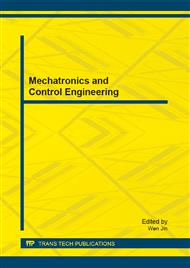[1]
R.T. Azuma et al. A survey of augmented reality. Presence-Teleoperators and Virtual Environments, 6(4):355–385, 1997.
DOI: 10.1162/pres.1997.6.4.355
Google Scholar
[2]
H. Bay, T. Tuytelaars, and L.V. Gool. SURF: Speeded Up Robust Features. In ISMAR '08 Proceedings of the 7th IEEE/ACM International Symposium on Mixed and Augmented Reality, pages 125–134, 2008.
Google Scholar
[3]
G. Bradski and A. Kaehler. Learning OpenCV: Computer vision with the OpenCV library. O'Reilly Media, 2008.
Google Scholar
[4]
M. Calonder, V. Lepetit, C. Strecha, and P. Fua. BRIEF: Binary Robust Independent Elementary Features . In ECCV, volume 6314, pages 778–792, 2010.
DOI: 10.1007/978-3-642-15561-1_56
Google Scholar
[5]
T. Fei, L. Xiao-hui, H. Zhi-ying, and H. Guo-liang. A Registration Method Based on Nature Feature with KLT Tracking Algorithm for Wearable Computers. In Cyberworlds, 2008 International Conference, pages 416 – 421, 2008.
DOI: 10.1109/cw.2008.29
Google Scholar
[6]
M. Fiala. Artag, an improved marker system based on artoolkit. 2010.
Google Scholar
[7]
F. Huang, Y. Zhou, Y. Yu, W. Zi-qiang, and D. Si-dan. PianoAR: A Markerless Augmented Reality Based Piano Teaching System . In Intelligent Human-Machine Systems and Cybernetics (IHMSC), volume 60, pages 91–110, 2011.
DOI: 10.1109/ihmsc.2011.82
Google Scholar
[8]
H. Kato and M. Billinghurst. Marker tracking and hmd calibration for a video-based augmented reality conferencing system. In iwar, page 85. Published by the IEEE Computer Society, 1999.
DOI: 10.1109/iwar.1999.803809
Google Scholar
[9]
D.G. Lowe. Distinctive Image Features from Scale-Invariant Keypoints . In International Journal of Computer Vision, volume 2, pages 47–52, 2004.
DOI: 10.1023/b:visi.0000029664.99615.94
Google Scholar
[10]
B.D. Lucas and T. Kanade. An iterative image registration technique with an application to stereo vision. In International Joint Conference on Artificial Intelligence, pages 674 – 679, 1981.
Google Scholar
[11]
Y. Pang, M. Yuan, A. Nee, S. Ong, and K. Youcef-Toumi. A markerless registration method for augmented reality based on affine properties. In AUIC '06 Proceedings of the 7th Australasian User interface conference, pages 25 – 32, 2006.
Google Scholar
[12]
E. Rublee, V. Rabaud, K. Konolige, and G. Bradski. ORB: An efficient alternative to SIFT or SURF . In ICCV, pages 2564 – 2571, 2011.
DOI: 10.1109/iccv.2011.6126544
Google Scholar
[13]
J. Shi and C. Tomasi. Good Features to Track. In CVPR, pages 593 – 600, 1994.
Google Scholar
[14]
C. Tomasi and T. Kanade. Detection and Tracking of Point Features. In Carnegie Mellon University Technical Report CMU-CS-91-132, 1991.
Google Scholar
[15]
D. Wagner, G. Reitmayr, A. Mulloni, T. Drummond, and D. Schmalstieg. Pose Tracking from Natural Features on Mobile Phones. In ICCV, pages 2564 – 2571, 2011.
DOI: 10.1109/ismar.2008.4637338
Google Scholar


